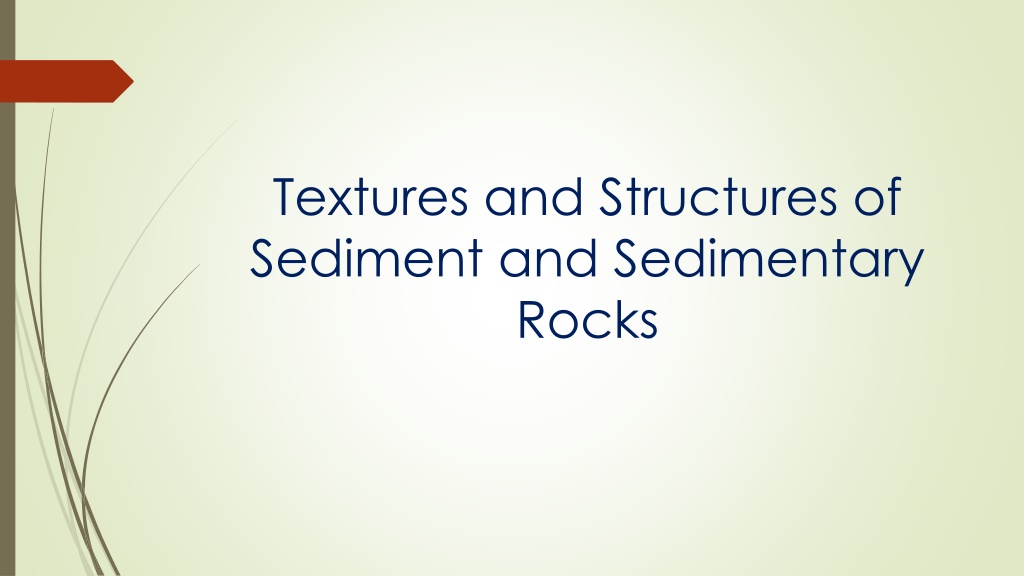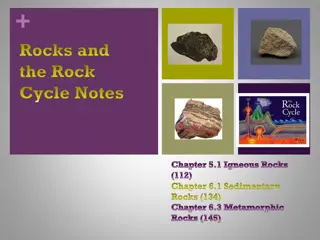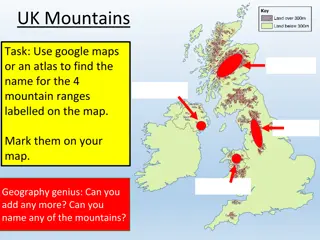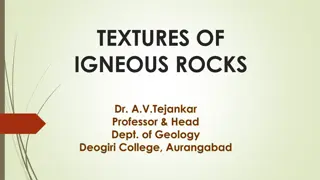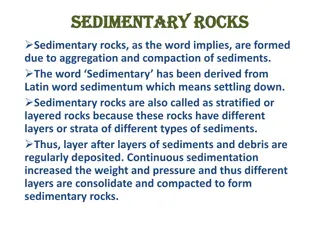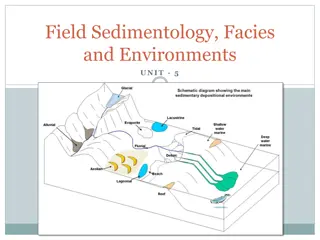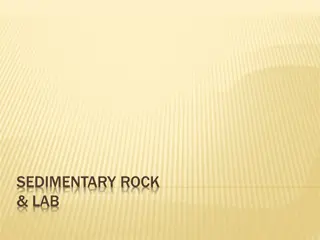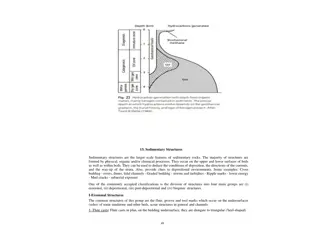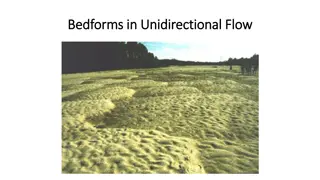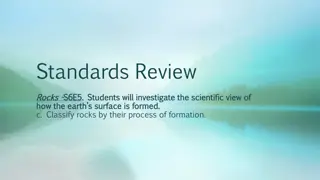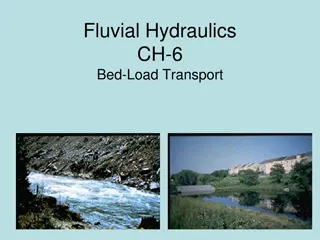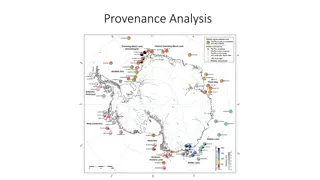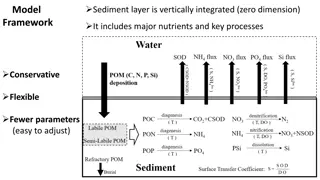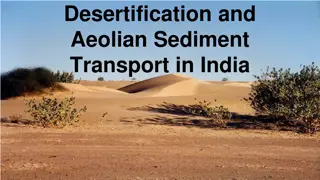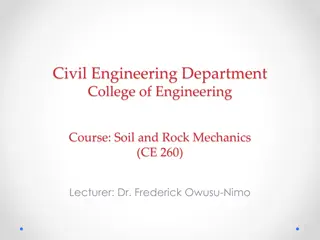Understanding Sediment and Sedimentary Rock Textures
Discover the textures and structures of sediment and sedimentary rocks, including clastic and crystalline textures, primary and secondary textures, and the effects of compaction. Learn about sediment texture, differences in sedimentary rock texture, and the classification of grain sizes using the Wentworth scale. Explore how particle size distributions can reveal information about depositional processes and environments. Gain insight into the grain-size classification for clastic sediments, from boulders to clay particles.
Download Presentation

Please find below an Image/Link to download the presentation.
The content on the website is provided AS IS for your information and personal use only. It may not be sold, licensed, or shared on other websites without obtaining consent from the author. Download presentation by click this link. If you encounter any issues during the download, it is possible that the publisher has removed the file from their server.
E N D
Presentation Transcript
Textures and Structures of Sediment and Sedimentary Rocks
Sediment Texture Sediment texture refers to the shape, size and three-dimensional arrangement of the particles that make up sediment or a sedimentary rock. Textures can be clastic or crystalline, it is clastic when they are composed of grains from pre-existing rocks and crystalline, when the crystals grew from a fluid producing an interlocking mosaic of crystals. Textures are primary or secondary, it is primary where the grains possess their arrangement that existed after they came to rest (or after precipitation in the case of crystals). In sedimentary rocks, however, textures are commonly secondary, because they have been altered in some way from their original condition. The most common effect is compaction, where the weight of overlying sediments causes the component grains to rearrange themselves or even become fractured.
Sedimentary rocks exhibit differences in texture: Definition of texture: the size and shape of the particle that make up the rock. Grain angularity Sphericity Size Sorting Which reflect: Derivation (original rocks) Climate (during formation) Post-depositional factors
Texture T Texture = Orientation (random/lined up), Size (measurements, all same?), Shape (rounded/angular), Sorting (well poor). Sedimentary rocks show great differences in their texture This relates back to their mode of formation O S S S
Grain Size Particles are generally measured by their maximum grain diameter. The most common classification is use is the Wentworth scale. In this classification, terms such as pebble, sand and gravel have well-defined limits. Many statistical methods can be applied to particle size distributions (e.g., median, mean, skewness, kurtosis, etc.) to try to characterize the depositional processes that produced them (e.g., wind, swash, etc.), and even to distinguish depositional environments. The Wentworth scale is a geometric scale--adjacent orders differ be a factor of two (either doubling or halving). A common practice in studying grain size distribution is to use the phi scale. As well as mm, the boundaries between each class can be expressed by the negative logarithm of this dimension to the base 2: (phi) = -log2 d where d is particle size in mm. Phi values are dimensionless, but because they are based on mm, the scale is metric.
Grain-Size Classification for Clastic Sediments Name Millimeters 4,096 256 64 Micrometers Boulder Cobble Pebble Granule Very Coarse Sand Coarse Sand Medium Sand Fine Sand Very Fine Sand Coarse Silt Medium Silt Fine Silt Very Fine Silt Clay 4 2 1 0.5 0.25 0.125 0.062 0.031 0.016 0.008 0.004 500 250 125 62 31 16 8 4 (modified from Blatt, 1982)
This figure shows how clastic sediment of various sizes will, after compaction and cementation, form different types of detrital sedimentary rocks. The process of sediment turning into rock is called lithification.
Shape Particle shape is difficult to quantify or describe. Shape is commonly described with reference to three axes at 90 to each other that can theoretically be placed inside any particle. The longest axis is a, shortest c and the intermediate is b. In a sphere or cube, those axes intersect at the centre and have equal length. By comparing the ratios of the axes, it is possible to describe four basic "shapes" of particles: oblate, equant, bladed and prolate. Shape is some cases reflects erosional processes (how the rock broke up with weathering and transportation), but may also reflect structures and fabrics present in the parent rock. Shale, for example, will commonly produce flat particles, whereas quartzite (metamorphosed sandstone) may be more equant.
The four main classes of grain shape, which are based upon the ratios of intermediate diameters of any particle (after Zingg 1935). the long, short and Angular little evidence of wear, sharp corners, little transport Increased sphericity - more spherical, rounded, corners smoothed off to broad curves, great amount of transport
Roundness Roundness (or angularity) refers to how smooth or sharp are the edges of particles. It is usually measured with reference to a comparative chart (The commonest is: Powers, M.C., 1953, A new roundness scale for sedimentary particles. Journal of Sedimentary Petrology, 23: 117-119) Roundness and sphericity are not the same thing. A grain with highly irregular shape can be well rounded; a cube has high sphericity but very low roundness..
Maturity Maturity is a function of sediment transport Textural maturity refers to: The degree of roundness of the grains The amount of sorting of the grain sizes Texturally mature sandstones have well-rounded and well- sorted grains, immature if not Mineralogical maturity refers to the percentage of quartz grains Feldspars break down with transport Quartz grains more resistant Mineralogically mature sandstones have mostly quartz grains Arkose is mineralogically immature
Sorting Sorting: increases with length of transportation history (weaker minerals broken down). Well sorted = particles nearly all the same size Current strength constant and for long periods of time Poorly sorted = particles of a great mix of sizes Current strength suddenly drops and material is dumped Sorting of the sediments also suggest the mode of deposition and transportation. Long distance transport= well-rounded and well-sorted sediments, Short distance transport = poorly sorted angular grains. Also helps in knowing the energy conditions of the river.
Grain shape Defined by ratio of dimensions of the fragment Length, breadth, thickness (a, b, c axes) Zingg classified shape into tabular, equant, blade and rod Some unusual: DREIKANTER/VENTIFACT wedge shaped (wind transport, desert)
Porosity/Permeability Obviously sorting links well to poroperm Well sorted, rounded, medium grain size has good pore spaces and will allow water to fall through quickly Poorly sorted, angular sediments have small pore spaces and trap water reducing permeability
